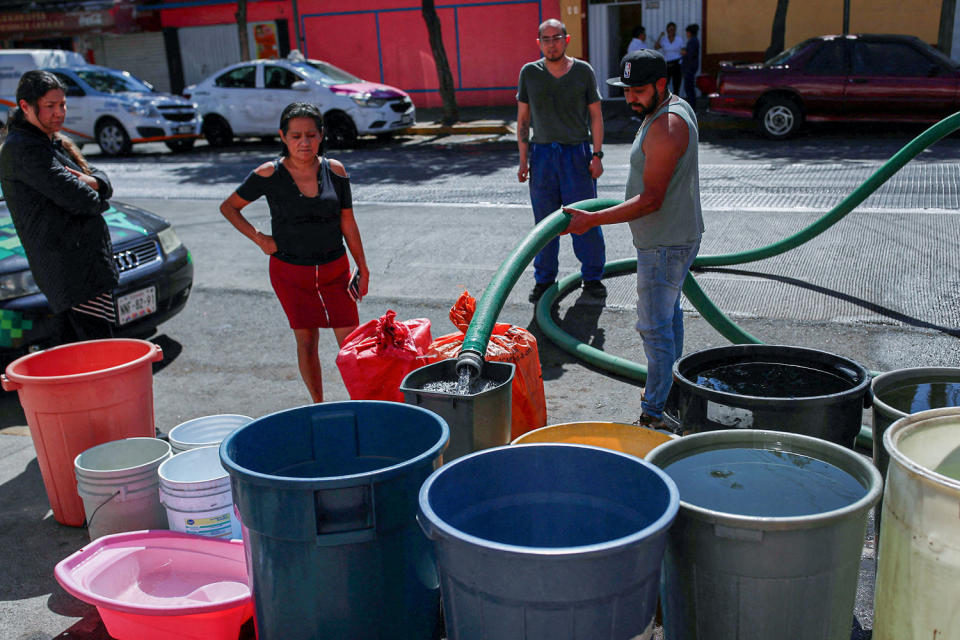MEXICO CITY – North America’s most populous city is in the grip of a severe water crisis as a prolonged drought and years of low rainfall are pushing the already strained system that provides running water to Mexico City to its limits.
More than 21 million residents in the Mexico City metropolitan area have been suffering from water shortages for weeks as local authorities imposed rationing as reservoirs reached historic lows.
Olga González, a 50-year-old housewife who lives in the Coyoacán neighborhood, said local authorities are using tanker trucks to provide running water to residents in the area, but it is not enough.
“Sometimes it takes four or five days for the trucks to arrive,” González said.

The scarcity means González must do as much as possible with the small amount of water available.
“I recycle water. “I go into the shower and collect the water to use in the toilet,” he said. “It’s the same for the washing machine. “I recycle the water from the flush cycle to use in the toilet.”
He added that he had to buy drinking water from the store because the water provided by the municipality was too dirty and chlorinated for consumption.
Nancy Cabrera Cepeda, a 40-year-old office worker in Mexico City’s Tlalpan district, said local authorities usually provide water to residents only once a week.
“We have a tank and it fills up when water comes, but we generally have no water supply,” he said.
Residents of Mexico City have unfortunately become all too familiar with these shortcomings, where poorly planned urban development, inadequate infrastructure, and the region’s unique history and geography have created a critical impact on the region’s water system.
Droughts intensified by climate change in recent years have further magnified these ongoing difficulties.
“Last year we spent two months without water,” said Estela Hernández Villa, a 42-year-old merchant living in the Iztapalapa district. “There are areas that go even longer without water.”
Darío Solano-Rojas, an associate professor in the department of Earth sciences engineering at the National Autonomous University of Mexico, said it is unlikely that the entire city will run out of water — a milestone sometimes referred to as “day zero” — but that the coming months will likely be challenging.
“If I run out of water, then it’s already day zero for me,” Solano-Rojas said. “This type of incident has been happening for a long time.”
The region’s complex relationship with water is as old as the city itself. Mexico City is located on a former high-altitude lake bed that was drained after the Spanish conquest of the region in the 16th century.
As a result, the city’s main water supply comes from pumping groundwater resources and channeling the network of canals, dams, and reservoirs that make up the Cutzamala System.
About 70% of water in Mexico City is pumped underground, Solano-Rojas said, while the Cutzamala System supplies the other 30% to the Mexico City metropolitan area and the nearby Toluca Valley.
But as the city expands rapidly, groundwater resources become stressed, and years of overuse cause the ground to collapse, a process known as subsidence.
A 2021 study co-authored by Solano-Rojas and published in the journal JGR Solid Earth found that groundwater extraction has caused the city to sink about 50 centimeters per year since 1950.
“The city is growing so much,” he said. “We have other water sources, but we still get water from underground, so subsidence continues, and it’s a problem that hasn’t stopped since the construction of the great pyramids in the city’s pre-Hispanic history.”
Local infrastructure has also failed to keep up with Mexico City’s growth rate, Solano-Rojas said, adding that authorities are scrambling to repair leaks and replace aging pipes to strengthen the region’s water system.
All of these issues are major challenges in themselves, but Solano-Rojas said climate change is further exacerbating the water crisis as the region suffers from ongoing drought conditions.
According to a recent report from Mexico’s National Water Commission (Conagua), the country was generally warmer and drier than normal. The agency found that last month was the warmest January on record, with average temperatures 1.26 degrees Fahrenheit warmer than normal for the month.
Warmer temperatures and less precipitation in central Mexico mean less chance of replenishing the groundwater and dams that feed the Cutzamala System.
“We are not ready to intervene so quickly because the drought is causing problems in Mexico City,” Solano-Rojas said.
All these stresses combined make it difficult for the city to provide sufficient water for human consumption, industrial activities and agriculture.
Many neighborhoods are suffering from famine.
“In the case of Iztapalapa, water scarcity has always been a big problem,” said Mariano Salazar, a 69-year-old community leader in the area. “We are almost 2 million people in this municipality and we need 100 million cubic meters of water a year.”
Frustration with the situation fueled unrest. Last month, protesters in the municipality of Acambay forced open the door of an office belonging to Mexico’s National Water Commission and broke the windows, Reuters reported.
Local officials have urged residents to conserve water and prioritize what is available for drinking, especially as temperatures hover around 85 degrees Fahrenheit this week.
For many, like Hernández Villa in Iztapalapa, famine causes great sacrifices every day.
“We try to wash our clothes as little as possible, we don’t use the shower anymore,” he said. “To save as much money as possible, we should leave water in containers and wash in jars. “We want the small amount of water we collect to last a little longer.”
Denise Chow reported from New York City and Albinson Linares reported from Mexico City.
This article first appeared on NBCNews.com.